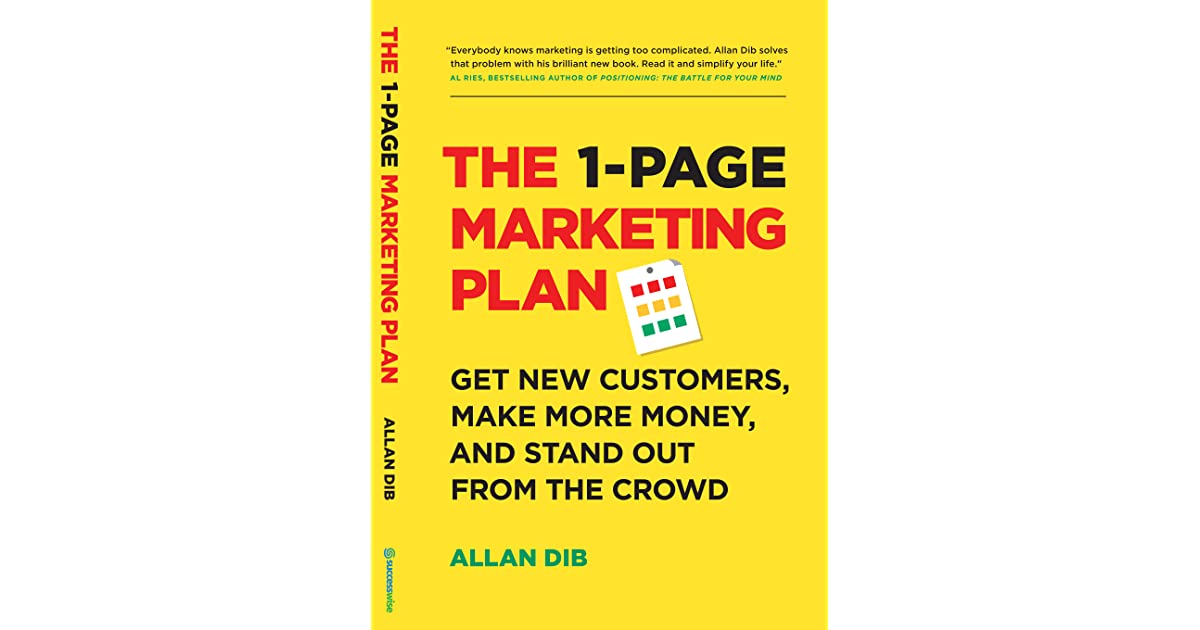What is Your Message to Your Target Market?
An analysis and commentary on The 1-Page Marketing Plan
The 1-Page Marketing Plan
About the Book:
In The 1-Page Marketing Plan, Allan Dib reveals a marketing implementation strategy to map out your own sophisticated marketing plan and go from zero to marketing hero.
About the Author:
Allan Dib is a passionate entrepreneur, rebellious marketer and technology expert. As a highly sought after business coach, consultant and public speaker, he frequently shares his proven strategies and cutting edge tactics with people all over the world.
YOUR MESSAGE GOALS
Advertising is a valuable asset in building sales and customers for your business. It is important that your ad have an objective, if it doesn’t meet that objective or help your company it has to go. This can be said about your company name and logo as well, ads help build your marketing business. A better practice for your ads instead of selling something directly is to invite customers to indicate their interest. This tactic generates less resistance and ads them to a marketing database that can be tracked and targeted easier. When getting potentials to show their interest you also need to be specific about what you want them to do, e.g. call a number to order, request a sample or report. Vague phrases such as “don’t hesitate to call us,” leaves too much leeway on what you want your customers to do.Using a Unique Selling Proposition(UPS) is one way to accomplish this. Having a strong UPS should convince your potentials of why they should buy from you and not your competitors. Many businesses use a UPS that guarantees “quality” or “great service” however it’s not the best strategy. Customers expect “quality” and “great service” from you already, especially after they’ve bought they know you are true to your word. Your UPS needs to reach people before they buy or feel the need to purchase. There are two defining questions you need to ask yourself and answer: Why should they buy and why should they buy from you? Your answers should be “clear, concise, and quantifiable.”
CRAFTING YOUR MESSAGE
When a customer becomes aware of a product they have roughly three options: buy from you, buy from a competitor, or do nothing. A common misconception about these options is that your competitors pose the biggest threat, when in actuality the propensity to spend is a larger challenge. The question of why they should buy should take priority when crafting your target message. First enticing a consumer to whatever your selling, then convincing them that your product is the best. Even if a consumer knows of your product and would choose you over a competitor, if they’re not buying it is a net loss. Take the example of Apple versus Samsung phones, through a series of advertisements a customer decides they like Apple products better, however this consumer wont need a new phone for another 2 years, so your messages energy is lost. Now that we have established the importance of buying intent we can set your company apart from others. Your message in favor of your company should be unique, this can come from many different places such as the way your product is packaged, additional services you offer in conjunction, or the way you sell it. Not only does this set you apart from your competitors, but by having more unique qualities you may even be able to charge higher prices or promote a different standard of service. By making your product remarkable you also turn better profits, customers who try your product are more satisfied, and satisfied customers share their experiences generating more customers. It is a self-fulfilling cycle.
YOUR PITCH
A simple way of testing and building an effective UPS is through an activity called the “elevator pitch.” The concept of an elevator pitch is that you can deliver a well-rehearsed, concise summary of your business and its “value proposition” within the span of an elevator ride (30-90sec.). The focus of a good marketing pitch should be providing a solution to a customer facing a problem. You want to be remembered for satisfying your customer more than you want them to remember an incomprehensible title or line of business. To effectively communicate this message you can follow a simple guide: “You know [problem]? Well, what we do is [solution]. In fact, [proof].” Easily you can insert what your company does and how you do it, you can spice up this message in an ad through many creative outlets, just make sure your main points still come through clear.
IN-DEPTH ON YOUR OFFERS
An important question to ask yourself is of all the products and services you offer which do you have the most confidence in delivering. This will be the most powerful of your products to market. Another way to say this is what problem are you sure you can solve for your target market? You can look at what the underlying satisfactions your consumers gain from your product to help you identify which would be best. For example, if you sell home insurance not only do you just sell that physical product but emotionally what people are buying from you is security and peace of mind. Attaching the emotional and underlying benefits of your products as further selling points can help your pitch and delivery. Now you can sell your consumers a story they can identify with not just a point blank product or service. The biggest downfalls for offers is the fact that most of them are unexciting or engaging.
Another important distinction to make in your offer is who you are selling to. You may have the best ad created for an outdoor enthusiast to by your one of a kind cooler but if its a businessman who is always traveling that sees your ad loses value. The best way to figure out what your potential prospects may want is by asking them, using surveys and other formal market research strategies you can find this out. Taking the same business that caters to outdoor enthusiasts, if they wanted to expand their consumers to business men they would need to find out what would attract them. A side not about market research is that many people who take surveys and answer questions think logically while the actual purchasing of items is more emotional. A more telling way you can analyze your market is to look at what they have already bought or are currently buying. There are many services and softwares out there that provide such a service, some can give insight on what’s trending, what people are reacting too, and tap into the global consciousness that is social media.
THE POWER OF WORDS
Using all the information we have gained from looking at what the company provides and what a target market may want we can now craft our message in the best form. Your offer needs to start with the basic information of knowing what your going to sell and to who from there your audience will guide the rest of your decisions. An important audience identifier that should be considered is language, what “jargon” do they use that identifies them with their market group. When you have a really compelling offer people can become skeptical about potential motive, using their language helps them trust you and the product easier. Another way you can encourage customers to purchase is “value stacking” adding more offers and additional bonuses can make your original offer look even more valuable and like a no-brainer. Often in info-commercials that you see on the tv you’ll hear the announcer say “order now and we’ll send you an additional (product), yours free!” On the same level of adding more products “upselling” is also an important part of business. Taking a salon as an example, a customer books a haircut guaranteeing a purchase but this is your opportunity to capitalize. Since they are already coming in you can also offer them a hair treatment or styling to compliment their service which can generate more sales for you.
Something to keep in mind across different business types is having a payment plan available. You may offer a high end and expensive service but for certain service you may include a payment plan that makes it more accessible and affordable to people. When you go to a department store some have Tv and computer displays, many would be out of the price range of a customer living with many bills and financial obligations. Instead of losing the sale completely a payment plan provides a more realistic option for some consumers. Another difference to keep in mind is having a high risk product(ex: stocks or market shares) and what assurances you can provide your consumers should they choose to invest. Giving consumers a guarantee when they invest whether small or large will entice them to take the risk of purchasing. Another strategy you can employ is scarcity. People respond more to fear of loss than the prospect of gain. Having seasonal or limited stock of products can become a strong selling point for your business.
PERCEPTION
Selling the features and benefits of your products instead of the having a price centric message entices your audience more. The timing aspects of your product should also be considered when developing a message. Pharmacists often sell medicine focused solely on curing an existing problem rather than preventing, this is because people often want instant gratification with their purchases. The relief you can provide with your product across any number of goods or services will see higher conversion rates and lower price resistance when following this model. An additional point on word perception is “salesmanship in print,” or attention grabbing headlines/calls to action that elicit direct emotional responses are sometimes seen as inappropriate but are necessary to understand. It has been more modernly dubbed “click bait” where a title may be overimbelished and exaggerated in comparison to the content it is representing. It targets what people would emotionally be more compelled to click on instead of what you’re selling in entirety.
People buy from people, not corporations, making sure you build a rapport and relationship with your customers makes them more inclined to purchase your product. From an emotional standpoint people care about personality, a consumer is much more likely to buy from a company that has a history of clean production and good employee treatment. Your ads can display your personality through words with strong emotional connotations and making sure that consumers can tell you are sincere. Authenticity makes your company approachable and humanizes you. Different ways to do this can be a short video on your website of someone explaining and describing your products, a talking-head can connect to your customers easier. You can also post on social media frequently addressing your target market and building history with relevant content from your business. Be unique, listen to your audience and provide what they want. Whether you’re the first within your business market to do something like this or not, it matters only what your customers will think. You have to take the fear element out of what your competitors do and how you may personally feel on the matter in order to be the most effective.
EMOTION VS. LOGIC
Something important to remember is that people buy with their emotions and justify with logic afterwards. Changing even one-word in your headline or message can alter the way it is received by your customers. Here are a few words that have been found most compelling: free, save, results, love, proven, easy, guaranteed. The five motivating aspects of human behavior are often named: greed, guilt, pride, fear, and love. Your sales copy should be focusing on one of these “hot press” buttons otherwise it is most likely not maximising impact and verging on timid and ineffective. Your headline is the most important part of your sales copy, it grabs your reader and pulls them in to actually get information and delve into your ad or message. It’s like a teaser add thats suppose to give them a glimpse into what your actual ad will contain and drive them to want to read it.
Some examples:
- They Laughed When I sat down at the Piano-But When I Started to Play!
- Who Else Wants a Screen Star Figure?
- An Open Letter to Every Overweight Person in Portland Is the Life of a Child Worth $1 to You?
- For more references: 1pmp.com
All of the above headlines grab your attention, give some glimpse into the content that would be featured, and leave enough unsaid to make the reader want to find out more. This should be the goal of all of your headlines. Some people may think manipulating emotion through ads is unethical such as targeting fear or guilt but like any tool it can be used for good or bad. You as a salesman are trying to make a profit and push your product but if you provide an honest service that does benefit your customers then you aren’t being underhanded or deceitful. If you have the best interest of the customer in mind then you are doing them a service making sure they know and feel compelled to buy your product instead of the competitions which may be inferior. Knowing your target markets influencing emotions can help you start a sale but you also need to be prepared to assuage their fears. It is inevitable that your customer will have doubts and work through all the risks that could be associated with your product. Your best practice should be to address those fears or concerns head on instead of shying away from them and letting the customer’s brain work it out. Potentially lost sales to the mind game of risk rationalization will be lessened and it will give your customers a more well-rounded picture of what you’re offering. Many customers don’t even voice their concerns because of the “polite” society we live in, most will differ to the “let me think about it” line. Your sales copy should not only say who or what your product is about but also who it is NOT for. It is your duty to make sure you aren’t selling to low-probability prospects, this will also help lessen complaints for misunderstandings and makes your more credible in the customer’s eyes. Selling your product as being unique and tailored for a certain set of needs makes it seem more exclusive and “best fit” for your intended audience.
RESPONSIBILITY
If you ask people why they haven’t had success with something some common responses are: the economy, government taxes are too high, poor upbringing. None of these responses however mention themselves or their own shortcomings. When a kid does something wrong their normal response is “It’s not my fault,” this is the same with adults. Most people don’t believe they are in the wrong. This applies to the way you need to take responsibility for the success of your company, it will always come back to you when there’s a problem. You should never be blaming your prospects, whenever they give an excuse that derails a sale or when they have a problem you are trying to solve you should never actively blame in your words or your actions. The best you can do to combat the blame game is to take their reasons or problems accept it and try to provide a solution. If the economy is bad and you see this as a common problem consider offering a layaway plan. If your customers have no time to come in and buy your product, offering an online purchasing or ordering solution may work wonders for you. Always try to find a way to accept the problem and provide a solution, those will turn out the best results.
YOUR NAME
Your name, whether for a company or product is your first impression and should be carefully thought of. A common problem with names is that they are too vague or “Inner circle.” If you have to explain your name in any way you have already gone wrong. Now you spend more time and money with advertisements and explanations to try to get across the basics of your company which should have been apparent in its naming. Just as we spoke about headlines being hooks into your ads, your name for your company or product needs to do the same. The title should equal content. “Fast Plumbing Repairs,” tells you exactly what you need to know about this company versus “Aqua Solutions.” Now you need to explain that aqua is water in latin and what you mean by solutions, is this for fixing bad pipes, cleaning/filtering water, maybe dealing with a leak in your house. Your customer has no idea from your name what you are all about. Often people out think themselves trying to be clever when simple is better. Confusing customers is the fastest and easiest way to lose a sale. It is difficult enough to have your customer, read, act, and engage with you in the beginning. You double your chance of creating a problem when you choose cleverness over clarity. If you need an opinion about your idea for a name it is good to ask for advice from others. However you want to be careful taking advice from friends or family because they are biased and tend to try to praise or compliment your for your ideas. While it may feel nice it may not be helpful and in your best interest.
HIGHLIGHTS:
- Your message is the most important part of your ad. Crafting something clear, concise, and targeted will have the best results.
- Understanding your target market physically and mentally will help you appeal to them and account for questions or concerns they may have.
- Appeal to your customers emotion not logic, people buy with their feelings and then rationalize second.
- Your words and language can either help or hinder you, be selective and decisive about how you write anything that pertains to your business name, product, or message.
REFERENCES:
The 1-Page Marketing Plan: Get New Customers, Make More Money, And Stand Out From The Crowd by Allan Dib






